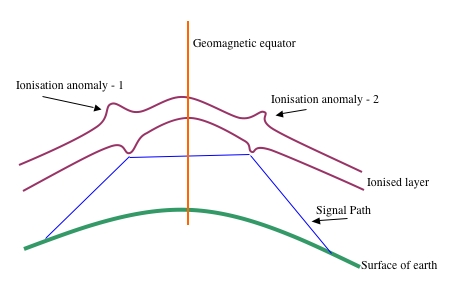Trans-Equatorial Propagation
Related wiki pages: Bands, Propagation, Aurora, Tropospheric ducting, Lightning scatter, Meteor scatter
Simplified ionospheric models portray the ionosphere as a series of horizontal layers that vary with time, location and sunspot activity. The real ionosphere is much more complex than this, particularly in in equatorial and polar regions.
What is Trans-Equatorial Propagation (TEP)?
Historically, the effect was first noticed in the 1940's by both military and amateur operators who discovered that it is possible to communicate in the VHF band over intercontinental distances during times of high sunspot activity.
The first organised and therefore relatively large scale TEP communications occurred during 1957-1958 in the peak of sunspot cycle 19. Sunspot peaks in 1970 (cycle 20) and 1977 (cycle 21) expanded our knowledge of the phenomenon.
When does TEP occur?
Two distinct types of TEP have been identified:
- those occuring during late afternoon and early evening, and usually over maximum distances of around 6000km. Contacts were restricted to the low VHF bands (6 metres for hams in most countries)
- those occuring around 1900 to 2300 local time, with workable contacts being made on 144MHZ(2 metres) and sometimes on 432MHz (70 centimetres)
Why does TEP occur over the Equator?
There are three general "zones" in the atmosphere of the Earth, Polar, Temperate and Equatorial. In terms of density, it has been found that equatorial ionosphereic areas are more dense than those over polar regions. This affects useable frequencies within those regions. Perhaps because they are at the "extremes" of the earth in terms of their exposure to the effects of the sun, the polar and equatorial regions are subject to various unusual and unexpected variations in ionospheric conditions - these often occuring in the F-Layer.
Perhaps the most interesting of these effects is known as the "equatorial anomoly". This occurs where a high electron concentration is found on each side of the magnetic equator, and is usually seen in the region of 10 to 20 degrees latitude.
Afternoon TEP is believed to occur when a signal is reflected first by an anomoly on one side of the equator and then again by another anomoly on the other side.
Evening TEP is less well understood, but is believed to rely on "ionospheric bubbles" - areas of high ionisation density off which signals are reflected.
What are the characteristics of afternoon TEP?
- Maximum useable frequency (MUF) up to about 60 MHz
- Occurs from around 1500 to 1900 local time.
- It is more prevalent near the equinoxes and at times of high sunspot number.
- Typical path lengths will be from 5000 to 6500 kilometres.
- Signals will normally be strong with limited fading and distortion
What are the characteristics of evening TEP?
- Occurs around 2000 to 2300 local time, and is more frequent around the equinoxes and especially at times of high sunspot activity
- Signals subject to rapid fading and strong distortion
- Signals may have doppler spread
- Path lengths are usually between 3000 and 8000 kilometres.
Is it possible to predict TEP conditions?
At the moment it is not possible to predict TEP conditions, but the following are indicative that those conditions may be possible.
- The receiver and transmitter should be located at equal distances from the magnetic equator.
- The path must be within about 15 degrees of geomagnetic north-south.
- the time is around the equinoxes.
- the Solar cycle is at a maximum - leading to highter ionospheric ionisation.
- The higher the F2 layer is over the geomagnetic equator the higher the occurrence rate of TEP.
- The further the equatorial anomalies are from the geomagnetic equator the higher the probability that afternoon TEP will occur
| Propagation and radio wave theory | |
| Propagation | Aurora * E-Skip * IPS * Lightning scatter * Meteor scatter * Satellites * Trans-Equatorial Propagation * Tropospheric ducting |
| Interference | QRM * QRN |
| Theory | Electromagnetic Waves * Frequency Wavelength and Period |
